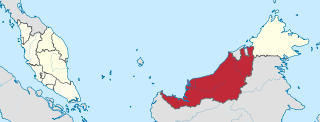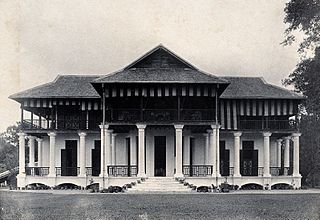Related Research Articles

Sarawak is a state of Malaysia. The largest among the 13 states, with an area almost equal to that of Peninsular Malaysia, Sarawak is located in East Malaysia in northwest Borneo, and is bordered by the Malaysian state of Sabah to the northeast, Kalimantan to the south, and Brunei in the north. The state capital, Kuching, is the largest city in Sarawak, the economic centre of the state, and the seat of the Sarawak state government. Other cities and towns in Sarawak include Miri, Sibu, and Bintulu. As of the 2020 Malaysia census, the population of Sarawak was 2.453 million. Sarawak has an equatorial climate with tropical rainforests and abundant animal and plant species. It has several prominent cave systems at Gunung Mulu National Park. Rajang River is the longest river in Malaysia; Bakun Dam, one of the largest dams in Southeast Asia, is located on one of its tributaries, the Balui River. Mount Murud is the highest point in the state. Sarawak is the only state of Malaysia with a Christian majority.

Sir Vyner Brooke, Rajah of Sarawak, GCMG, full name Charles Vyner de Windt Brooke was the third and last White Rajah of the Raj of Sarawak.

The White Rajahs were a hereditary monarchy of the Brooke family, who founded and ruled the Raj of Sarawak as a sovereign state, located on the north west coast of the island of Borneo in Maritime Southeast Asia, from 1841 to 1946. Of British origin, the first ruler, James Brooke was granted the province of Kuching – which was known as Sarawak Asal – by the Sultanate of Brunei for helping fight piracy and insurgency among the indigenous peoples in 1841 and received independent kingdom status.
Abang Openg bin Abang Sapiee was a Malaysian politician who served as the first Yang di-Pertua Negeri of Sarawak from September 1963 to his death in March 1969. He assumed the newly established post following Sarawak's independence from Great Britain and the formation of Malaysia in 1963. He is the father to Abang Abdul Rahman Zohari Abang Openg, the current Premier of Sarawak.

The flag of Sarawak, officially known as Ibu Pertiwi, is the official flag of Sarawak, a state in Malaysia. It is based on the flag of the Raj of Sarawak of the White Rajah, and includes the yellow of Southeast Asian royalty — a similar yellow and diagonal black are in the flag of Brunei, although Brunei's yellow is of a brighter shade.
Tan Sri Datuk Amar Ong Kee Hui was a Malaysian Chinese politician and founder cum first president of the Sarawak United People's Party which was founded on 12 June 1959. His family trace their origins to Longhai, Zhangzhou, Fujian Province, China.

The Raj of Sarawak, Kingdom of Sarawak or State of Sarawak, was an independent state founded in 1841 in northwestern Borneo and was in a treaty of protection with the United Kingdom from 1888. It was established from a series of land concessions acquired by the Englishman James Brooke, from the Sultan of Brunei. Sarawak was recognised as a sovereign state by the United States in 1850 and by the United Kingdom in 1864. The Kingdom is now the Malaysian state of Sarawak.

Anthony Walter Dayrell Brooke was appointed the Rajah Muda of Sarawak on 25 August 1937, by his uncle, Rajah of Sarawak, Charles Vyner Brooke, the third and last ruling White Rajah.

The History of Sarawak can be traced as far as 40,000 years ago to the paleolithic period where the earliest evidence of human settlement is found in the Niah caves. A series of Chinese ceramics dated from the 8th to 13th century AD was uncovered at the archeological site of Santubong. The coastal regions of Sarawak came under the influence of the Bruneian Empire in the 16th century. In 1839, James Brooke, a British explorer, first arrived in Sarawak. Sarawak was later governed by the Brooke family between 1841 and 1946. During World War II, it was occupied by the Japanese for three years. After the war, the last White Rajah, Charles Vyner Brooke, ceded Sarawak to Britain, and in 1946 it became a British Crown Colony. On 22 July 1963, Sarawak was granted self-government by the British. Following this, it became one of the founding members of the Federation of Malaysia, established on 16 September 1963. However, the federation was opposed by Indonesia, and this led to the three-year Indonesia–Malaysia confrontation. From 1960 to 1990, Sarawak experienced a communist insurgency.

The Sarawak State Legislative Assembly is the legislative chamber of the unicameral legislature of the Malaysian state of Sarawak; the Yang di-Pertua Negeri of Sarawak forms the other part of the legislature. The Assembly is modelled after the traditions of the Westminster parliamentary system, which originates from the practices of the British Parliament. The executive branch of government is drawn from the elected members of the Assembly. The State Legislative Assembly sits at the Sarawak State Legislative Assembly Building located in Petra Jaya in Kuching, the state capital.

The anti-cession movement of Sarawak was a movement in Sarawak to fight against the British attempt to govern Sarawak as a crown colony rather than a protectorate ruled by the White Rajahs. The movement lasted from 1 July 1946 until March 1950.

Borneo Company Limited, formed in 1856, was one of the oldest companies based in East Malaysia.

The Crown Colony of Sarawak was a British Crown colony on the island of Borneo, established in 1946, shortly after the dissolution of the British Military Administration. It was succeeded as the state of Sarawak through the formation of the Federation of Malaysia on 16 September 1963.

The Proclamation of Malaysia was a statement, written in English and Malay, that declared the merger of the Federation of Malaya with the State of Singapore and the British crown colonies of North Borneo and Sarawak into the new Federation of Malaysia, following the enactment of the Malaysia Agreement and the Malaysia Act 1963 that July. The merger came into effect on 16 September 1963, and the proclamation was delivered on that date by Prime Minister Tunku Abdul Rahman in the Stadium Merdeka in Kuala Lumpur.

The 18-point agreement, or the 18-point memorandum, was a purported list of 18 points drawn up by Sarawak, proposing terms to form Malaysia, during negotiations prior to the creation of the new federation in 1963. Unlike the Sabah's 20-point memorandum whose authors are known and well documented, no such details have been produced for the so-called Sarawak 18-points memorandum.
Sarawak issued stamps that functioned as both postage and revenue purposes from 1869 to 1949 from the period of Raj of Sarawak, Japanese occupation, British Military Administration, to Crown Colony of Sarawak.

The British Military Administration (BMA) was the interim administrator of British Borneo between the end of the Second World War and the establishment of the Crown colonies of Sarawak and North Borneo in 1946. Specifically, the entity lasted from 12 September 1945 to 1 July 1946. Labuan became the headquarters of BMA. The headquarters was mostly managed by the Australian Imperial Force (AIF). The area under this administration today comprises Labuan, Sabah, Sarawak, and Brunei. Sarawak was administered by Australians under British Borneo Civil Affairs Unit (BBCAU).
Elections in Sarawak have been held in the Malaysian state of Sarawak since 1959 and have chosen Sarawak's elected representatives in the Dewan Rakyat and Dewan Undangan Negeri.
The second Sarawak district council elections was held in 1963. The results of the election was announced from 18 to 25 June 1963. A total of 185,000 voters cast votes in this election, and a total of 998 candidates were vying for 429 district council seats in Sarawak.
Constitution of the State of Sarawak was incorporated in 1963 in the state of Sarawak following the formation of federation of Malaysia. It consists of six Chapters, 58 Articles, and one Schedule.
References
- 1 2 3 4 5 6 7 8 Porritt, Vernon L (2007). "Constitutional change in sarawak 1963-1988: 25 years as a state within the federation of Malaysia". Borneo Research Bulletin. 38: 159–171. Archived from the original on 19 April 2023. Retrieved 19 April 2023.
{{cite journal}}: CS1 maint: bot: original URL status unknown (link) - ↑ "New Constitution for Sarawak". The Advertiser (Aldelaide, South Australia). National Library of Australia. 25 September 1941. Retrieved 2 May 2023.
- ↑ Porritt, Vernon L (1994). British colonial rule in Sarawak, 1946-1963 (PhD thesis). Murdoch University.
- ↑ Brooke, Charles Vyner (1941). – via Wikisource.
- ↑ "Sarawak (constitution)". Parliamentary Debates (Hansard) . 24 July 1946. Archived from the original on 16 February 2023. Retrieved 1 May 2023.
- ↑ Mathews, Philip (2014). Chronicle of Malaysia 1963-2013: Fifty Years of Headline News. Singapore: Editions Didier Millet. p. 25. ISBN 9789671061749 . Retrieved 7 May 2023.
- ↑ How Pim, Lim (25 October 2015). "Revisit 18-Point Agreement". The Borneo Post. Archived from the original on 8 June 2021. Retrieved 7 May 2023.